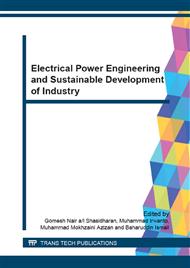[1]
R.C. Dugan et al., Electrical Power Systems Quality (2nd Ed. ), USA, McGraw-Hill, (2004).
Google Scholar
[2]
F. Batrinu et al., Experimental evaluation of unbalance and distortion indicators in three-phase systems with neutral, Power Tech, 2007 IEEE Lausanne, (2007).
DOI: 10.1109/pct.2007.4538535
Google Scholar
[3]
M. Chindris et al, Neutral currents in large public lighting network, Int. Conf. on Renewable Energies and Power Quality, (2004).
Google Scholar
[4]
G. Chicco et al. "Triplen harmonics: Myths and reality, Elect. Power Syst. Research, Vol. 81(7), pp.1541-1549, (2011).
DOI: 10.1016/j.epsr.2011.03.007
Google Scholar
[5]
Requirements for Electrical Installation, British Standard 7671, (2008).
Google Scholar
[6]
Electrical Installations of Buildings: Part 5-52: Selection and Erection of Electrical Equipment-Wiring systems, IEC 60364-5-52, (2009).
Google Scholar
[7]
P. Y. Du and X. H. Wang, Electrical and Thermal Analyses of Parallel Single-Conductor Cable Installations, IEEE Trans. Ind. Appl., Vol. 46(4), pp.1534-1540, (2010).
DOI: 10.1109/tia.2010.2049819
Google Scholar
[8]
Electric Cables-Calculation of Current Rating Part 1: Current rating equations (100% load factor) and calculation of losses-Section 1: General, IEC 287-1-1, (1994).
DOI: 10.3403/30122008u
Google Scholar
[9]
A. Hiranandani, Calculation of cable ampacities including the effects of harmonics, IEEE Ind. Appl. Mag., Vol. 4(2), pp.43-51, Apr. (1998).
DOI: 10.1109/2943.655660
Google Scholar
[10]
J. Blackledge et al., Cable Heating Effects due to Harmonic Distortion in Electrical Installations, Proc. of the World Congr. on Engineering 2012, London, UK, 2012, pp.928-933.
Google Scholar
[11]
K. O'Connell, Heating effects through harmonic distortion on electric cables in the built environment, Ph. D dissertaion, Dublin Energy Laboratory, Dublin Inst. of Tech., Ireland, (2013).
Google Scholar
[12]
H. D. Campbell and L. J. Hiivala, Design and Manufacture of Extruded Solid-Dielectric Power Distribution Cables, in Power and Communication Cables: Theory and Application, R. Bartnikas and K. D. Srivastava, Eds. John Wiley and Sons, Inc., (2000).
DOI: 10.1109/9780470545546.ch3
Google Scholar
[13]
J. Blackledge et al., Proximity Heating Effects in Power Cables, IAENG Eng. Letters, Vol. 21(3), pp.108-118, (2013).
Google Scholar
[14]
A. K. Hiranandani, Effects of harmonics on the current carrying capacity of insulated power cables used in three phase electrical power distribution systems, Electricity Distribution, 2005. CIRED 2005. 18th Int. Conf. and Exhibition (2005).
DOI: 10.1049/cp:20051044
Google Scholar
[15]
Tenaga Cable Industries Sdn. Bhd., PVC Insulated Cables (Malaysia).
Google Scholar
[16]
J. L. Blackburn, Symmetrical Components for Power Systems Engineering, USA, Marcel Dekker, Inc., (1993).
Google Scholar
[17]
A. Kot et al., Analysis of impact of nonlinear loads on losses in power network elements, Elect. Review, (2012).
Google Scholar
[18]
M. J. H. Rawa et al., Simulation of non-linear loads for harmonic studies, Elect. Power Quality and Utilisation (EPQU), 11th Int. Conf., pp.1-6, Oct. (2012).
Google Scholar


